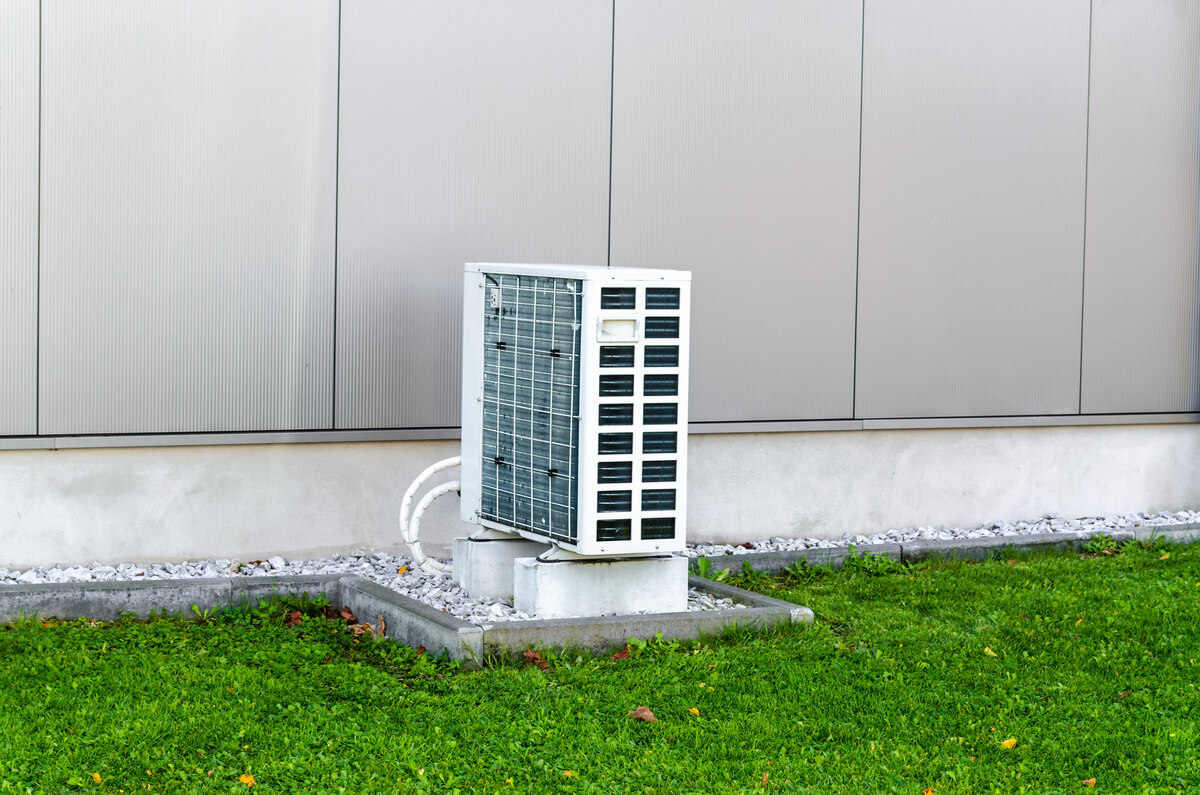Home>Home Maintenance>How Does Air Conditioning Work In Electric Cars


Home Maintenance
How Does Air Conditioning Work In Electric Cars
Modified: March 6, 2024
Discover how air conditioning systems work in electric cars and learn about their maintenance requirements. Stay cool and comfortable on your journeys with efficient home-maintenance for your electric vehicle.
(Many of the links in this article redirect to a specific reviewed product. Your purchase of these products through affiliate links helps to generate commission for Storables.com, at no extra cost. Learn more)
Introduction
As the world continues to shift towards sustainable transportation, electric cars have become increasingly popular. With their eco-friendly features and reduced carbon emissions, electric cars offer a promising solution for a greener future. However, one common concern for electric car owners is how their vehicles’ air conditioning systems function.
In this article, we will explore the basics of air conditioning and how it operates in electric cars. We will delve into the components of an electric car’s air conditioning system and discuss its energy efficiency. Additionally, we will highlight the challenges faced in air conditioning for electric cars and the improvements being made in this area.
Understanding how air conditioning works in electric cars is vital for both electric vehicle owners and those considering making the switch. So let’s dive in and uncover the inner workings of air conditioning in electric cars!
Key Takeaways:
- Electric cars use air conditioning systems that can impact their driving range. Manufacturers are working on advanced technologies to make the systems more energy-efficient and maintain a comfortable cabin environment.
- Air conditioning in electric cars is evolving to balance passenger comfort and energy efficiency. Innovations like smart controls, heat pumps, and improved insulation aim to enhance the driving experience while reducing environmental impact.
Read more: How Does Marine Air Conditioning Work
Basics of Air Conditioning
Air conditioning is a technology that provides thermal comfort by cooling and dehumidifying indoor spaces. It is achieved by removing heat and moisture from the air, creating a more pleasant and comfortable environment.
The basic principle of air conditioning involves the use of refrigerants, which are substances capable of absorbing and releasing heat quickly. The refrigerant circulates through the air conditioning system in a closed loop, undergoing different stages to cool the air.
The process begins with the refrigerant entering the compressor, where it is compressed and its pressure and temperature increase. The high-pressure, high-temperature gas then enters the condenser, where it releases heat to the surroundings and transforms into a high-pressure liquid.
The liquid refrigerant then flows into the expansion valve, where its pressure is reduced, causing it to evaporate into a low-pressure gas. This evaporation absorbs heat from the surrounding air, significantly lowering the air temperature.
Next, the cooled air is blown over the evaporator coil, which contains the circulating refrigerant. As the air passes over the coil, the heat from the air is absorbed by the refrigerant, further reducing the air temperature. The cooled air is then distributed back into the indoor space through vents or ducts.
Simultaneously, the refrigerant, now in a gaseous state, returns to the compressor to start the cycle anew.
It’s important to note that in most air conditioning systems, the process involves dehumidification as well. As the air cools, moisture in the air condenses on the evaporator coil and is collected and drained away, reducing the humidity of the indoor space.
This basic understanding of how air conditioning functions forms the foundation for comprehending how it operates in electric cars. With this knowledge, we can explore the unique aspects of air conditioning in electric vehicles and the challenges it presents.
Air Conditioning in Electric Cars
Air conditioning in electric cars operates on the same fundamental principles as traditional air conditioning systems. However, there are a few key differences and considerations specific to electric vehicles.
One significant distinction is that air conditioning in electric cars can impact the vehicle’s range. Electric cars rely on a battery to power all their systems, including the air conditioning. Running the air conditioning can consume a significant amount of energy, which can reduce the driving range of the vehicle.
To mitigate this energy consumption, many electric cars employ advanced systems that optimize air conditioning efficiency. These systems focus on minimizing the energy required to cool the cabin while still providing a comfortable environment for passengers.
Another aspect to consider is the impact of extreme temperatures on the performance of electric car batteries. Both high temperatures, such as during summer, and low temperatures, as in winter, can affect the battery’s efficiency and longevity. Therefore, maintaining an optimal temperature inside the vehicle becomes crucial.
Additionally, unlike traditional internal combustion engine vehicles, electric cars can utilize the “pre-conditioning” feature. This feature allows the owner to remotely activate the air conditioning system before entering the car, ensuring a comfortable temperature while minimizing battery usage. Pre-conditioning can be controlled through mobile apps or vehicle key fobs.
Furthermore, modern electric vehicles often employ advanced cabin climate control systems that include features like automatic temperature adjustment, individual zone controls, and energy-efficient heat pumps. These innovations contribute to better energy utilization and passenger comfort.
Overall, air conditioning in electric cars plays a vital role in passenger comfort and maintaining optimal battery performance. Manufacturers continue to improve and refine the air conditioning systems in electric vehicles to enhance energy efficiency and maximize driving range.
Components of Air Conditioning in Electric Cars
The air conditioning system in electric cars consists of several key components that work together to provide efficient cooling and heating. Let’s take a closer look at these components:
- Compressor: The compressor is responsible for compressing the refrigerant gas, increasing its pressure and temperature before it flows into the condenser.
- Condenser: The condenser is a heat exchanger located at the front of the vehicle. It cools down the hot refrigerant gas, causing it to condense into a liquid state by transferring heat to the surrounding air.
- Expansion Valve: The expansion valve is a metering device that regulates the flow of the refrigerant into the evaporator. It reduces the pressure of the refrigerant, allowing it to expand and evaporate, absorbing heat from the air.
- Evaporator: The evaporator is another heat exchanger located inside the vehicle. It cools down the warm air from the cabin as the refrigerant evaporates, removing heat and moisture from the air.
- Blower Fan: The blower fan is responsible for circulating air over the evaporator, distributing the cooled air throughout the cabin.
- Heater Core: The heater core is a small radiator-like component that uses engine coolant to provide heat for the cabin during colder months. In electric cars, it may be supplemented or replaced by a heat pump.
- Filters: Air conditioning systems in electric cars often include filters to remove dust, pollutants, and allergens from the incoming air, ensuring clean and fresh air inside the cabin.
- Control Panel: The control panel allows passengers to adjust the temperature, fan speed, and other settings of the air conditioning system.
These components work in harmony to create a comfortable and controlled climate inside the electric vehicle. By understanding how each component functions, manufacturers can continuously improve the efficiency and effectiveness of air conditioning in electric cars.
Tip: Air conditioning in electric cars works similarly to traditional cars, using a compressor to cool and circulate refrigerant through the system. However, electric cars may use a heat pump system for more efficient cooling and heating.
Operation of Air Conditioning in Electric Cars
The operation of the air conditioning system in electric cars follows a similar process to traditional air conditioning systems. However, there are some specific considerations related to electric vehicles. Let’s take a closer look at how air conditioning operates in electric cars:
- User Inputs: The driver and passengers set their desired temperature and fan speed using the controls on the dashboard or the vehicle’s infotainment system.
- Sensor Inputs: The air conditioning system receives input from various sensors, such as temperature sensors, humidity sensors, and sunlight sensors. These sensors provide real-time information about the cabin environment.
- Control Unit: Based on the user inputs and sensor data, the control unit manages the operation of the air conditioning system. It regulates the compressor, blower fan, and other components to achieve the desired temperature and maintain a comfortable cabin environment.
- Compressor Activation: When the air conditioning is initiated, the control unit activates the compressor. The compressor pressurizes the refrigerant gas, increasing its temperature.
- Heat Dissipation: The high-pressure refrigerant flows into the condenser, located at the front of the vehicle. As the refrigerant passes through the condenser, it releases heat to the surrounding air, causing it to cool and condense into a liquid state.
- Cooling and Dehumidification: The liquid refrigerant then flows through the expansion valve, where its pressure is reduced, allowing it to evaporate and absorb heat from the incoming air. As the air passes over the evaporator, it cools down, and moisture from the air condenses on the evaporator coil, dehumidifying the air.
- Circulation: The blower fan circulates the cooled and dehumidified air over the evaporator, distributing the conditioned air throughout the cabin.
- Temperature Monitoring and Adjustments: The sensors continuously monitor the cabin temperature, and the control unit adjusts the operation of the air conditioning system accordingly to maintain the desired temperature.
During this process, the air conditioning system may draw power from the vehicle’s battery, leading to a slight reduction in the driving range. Manufacturers are constantly working on improving the energy efficiency of air conditioning systems in electric cars to minimize this impact.
It’s important to note that some electric cars may also offer a heat pump system, which uses a reverse refrigeration cycle to provide both heating and cooling. This system utilizes excess heat from the electrical components or the outside environment to warm the cabin during colder weather, reducing the need for energy-consuming heating elements.
Overall, the operation of the air conditioning system in electric cars focuses on providing a comfortable cabin environment while optimizing energy efficiency to extend the vehicle’s driving range.
Energy Efficiency of Air Conditioning in Electric Cars
The energy efficiency of air conditioning in electric cars is a critical consideration due to its potential impact on the vehicle’s driving range. In an electric vehicle, every bit of energy consumed by the air conditioning system directly affects the available power for propulsion.
Manufacturers are continuously working on improving the energy efficiency of air conditioning systems in electric cars. Here are some key factors influencing the energy efficiency:
- System Design: Efficient system design involves optimizing the components and layout of the air conditioning system to minimize energy consumption. This includes using low-power components, reducing refrigerant volume, and fine-tuning the control algorithms.
- Insulation and Sealing: Proper insulation and sealing are vital to prevent heat transfer between the cabin and the surroundings. Well-insulated vehicles require less energy to maintain a comfortable temperature, reducing the load on the air conditioning system.
- Smart Pre-conditioning: Electric vehicles often offer the option for pre-conditioning the cabin while the vehicle is still charging. This allows the cabin to cool or heat up to the desired temperature using external power, rather than relying on battery power while driving.
- Zonal Climate Controls: Zonal climate controls enable individual temperature settings for different areas of the vehicle. This allows passengers to customize their comfort and avoids wasteful cooling of unoccupied areas.
- Sensor-based Controls: Advanced sensor technology allows the air conditioning system to adjust its operation based on real-time cabin conditions. For example, the system can reduce cooling when the cabin is unoccupied or optimize the airflow to areas with occupants.
- Heat Pump Technology: Many electric vehicles now utilize heat pump technology for heating and cooling. Heat pumps are more energy-efficient than traditional resistive heating elements, as they transfer heat from the ambient environment, such as the air or a coolant circuit, to warm the cabin.
By integrating these energy-saving features and employing smart control strategies, manufacturers are striving to strike a balance between passenger comfort and energy efficiency. The ultimate goal is to minimize the impact of air conditioning on the driving range of electric vehicles.
It’s worth noting that drivers can also adopt certain practices to enhance energy efficiency. For instance, using the recirculation mode when the outside air is not needed can reduce the workload on the air conditioning system. Additionally, parking in shaded areas and utilizing vehicle cooling features during charging can help maintain a comfortable cabin temperature without solely relying on the air conditioning system while driving.
Continued advancements in technology and a focus on energy-efficient designs will ensure that air conditioning systems in electric cars become even more efficient in the future, contributing to the overall sustainability of electric transportation.
Challenges and Improvements in Air Conditioning for Electric Cars
While air conditioning in electric cars has made significant progress, there are still some challenges that manufacturers are actively addressing. Here are some of the challenges and ongoing improvements in air conditioning for electric cars:
- Energy Consumption: One of the primary challenges is minimizing the energy consumption of the air conditioning system to preserve the driving range of electric vehicles. Manufacturers are focusing on improving system efficiency through the use of advanced technologies, such as smart controls, heat pumps, and optimized system designs.
- Battery Impact: The operation of air conditioning systems can have a direct impact on the performance and lifespan of electric vehicle batteries. Extreme temperatures, both hot and cold, can affect battery efficiency and overall longevity. To mitigate this impact, manufacturers are exploring innovative thermal management solutions to regulate battery temperature and optimize performance.
- Rapid Temperature Changes: Electric vehicles face challenges when it comes to rapid temperature changes, such as getting into a hot car on a summer day or defrosting a windshield on a cold winter morning. Improvements in insulation, pre-conditioning features, and faster heating and cooling response times are being developed to address this challenge.
- Localization of Cooling: Electric vehicles can benefit from localized cooling systems that concentrate air conditioning resources in occupied areas, reducing overall energy consumption. Advanced zonal climate controls and personalized cooling technologies are being explored to improve passenger comfort while minimizing energy usage.
- Integration with Renewable Energy: As the use of renewable energy sources grows, integrating air conditioning systems in electric vehicles with renewable energy systems is an area of focus. This would allow electric vehicles to utilize clean energy for cooling and contribute to overall sustainability.
- Filtration and Indoor Air Quality: Improving air quality inside electric vehicles is another challenge. Enhanced filtration systems and sensors are being developed to remove pollutants and allergens from the cabin air, providing a healthier and more comfortable environment.
Manufacturers and researchers are actively working on these challenges to enhance the performance, efficiency, and overall user experience of air conditioning systems in electric cars. Through continuous innovation, these improvements will ensure that electric vehicle owners can enjoy a comfortable cabin climate while maximizing energy efficiency and minimizing environmental impact.
Conclusion
Air conditioning is a crucial component of modern electric cars, providing a comfortable and controlled cabin environment for passengers. Understanding the basics of air conditioning and its operation in electric vehicles is essential for both electric vehicle owners and those considering making the switch.
While there are challenges in the realm of air conditioning for electric cars, manufacturers are continually improving the technology to enhance energy efficiency and optimize performance. The integration of smart controls, heat pump technology, zonal climate controls, and advanced thermal management systems demonstrates the commitment to maximizing driving range and passenger comfort.
Additionally, improvements in insulation, filtration, and air quality contribute to a healthier and more enjoyable driving experience. Future advancements aim to address challenges such as rapid temperature changes, battery impact, and the integration of air conditioning systems with renewable energy sources.
As the world transitions towards a more sustainable future, electric cars have emerged as a viable alternative to traditional internal combustion engine vehicles. By increasing the energy efficiency of air conditioning systems and considering the environmental impact of cooling and heating processes, electric vehicles become even more sustainable and attractive options for eco-conscious consumers.
Ultimately, air conditioning in electric cars plays a significant role in providing a comfortable and efficient driving experience. With continued research and innovation, air conditioning systems in electric vehicles will improve, enhancing the overall performance and desirability of electric cars while reducing their environmental footprint.
So whether you’re an electric vehicle owner enjoying a cool and refreshing ride on a hot summer day or considering purchasing an electric car in the future, rest assured that air conditioning technology in electric vehicles will continue to evolve, making your driving experience more enjoyable and sustainable.
Frequently Asked Questions about How Does Air Conditioning Work In Electric Cars
Was this page helpful?
At Storables.com, we guarantee accurate and reliable information. Our content, validated by Expert Board Contributors, is crafted following stringent Editorial Policies. We're committed to providing you with well-researched, expert-backed insights for all your informational needs.














